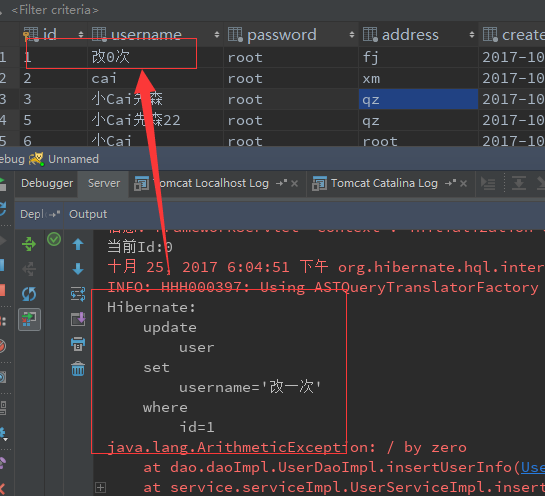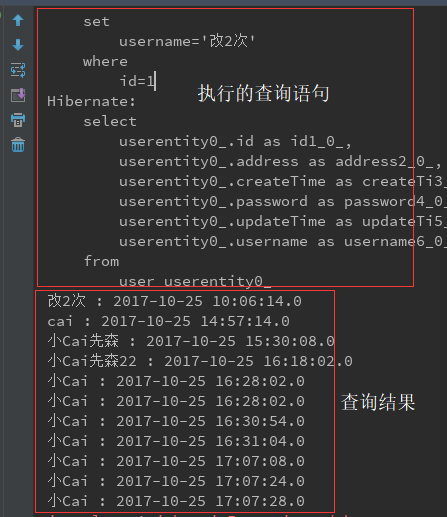关于 Spring 事务 理解
一、事务相关概念
1.事务由四个特性:ACID
-
-
- 原子性(Atomicity):事务是一个原子操作,由一系列动作组成。事务的原子性确保动作要么全部完成,要么完全不起作用【 要么做,要么不做 】
- 一致性(Consistency):一旦事务完成(不管成功还是失败),系统必须确保它所建模的业务处于一致的状态,而不会是部分完成部分失败。在现实中的数据不应该被破坏。【 操作一致,保数据完整 】
- 隔离性(Isolation):可能有许多事务会同时处理相同的数据,因此每个事务都应该与其他事务隔离开来,防止数据损坏。【 处理数据独立,互不干扰 】
- 持久性(Durability):一旦事务完成,无论发生什么系统错误,它的结果都不应该受到影响,这样就能从任何系统崩溃中恢复过来。通常情况下,事务的结果被写到持久化存储器中。【 数据持久保存 】
-
2.事务传播行为: 当事务方法被另一个事务方法调用时,必须指定事务应该如何传播 。
-
-
- PROPAGATION_REQUIRED 支持当前事务,如果当前没有事务,就新建一个事务。这是最常见的选择。
- PROPAGATION_SUPPORTS 支持当前事务,如果当前没有事务,就以非事务方式执行。
- PROPAGATION_MANDATORY 支持当前事务,如果当前没有事务,就抛出异常。
- PROPAGATION_REQUIRES_NEW 新建事务,如果当前存在事务,把当前事务挂起。
- PROPAGATION_NOT_SUPPORTED 以非事务方式执行操作,如果当前存在事务,就把当前事务挂起。
- PROPAGATION_NEVER 以非事务方式执行,如果当前存在事务,则抛出异常。
- PROPAGATION_NESTED 如果一个活动的事务存在,则运行在一个嵌套的事务中. 如果没有活动事务, 则按TransactionDefinition.PROPAGATION_REQUIRED 属性执行。
-
3.事务隔离级别
-
-
- Read Uncommitted(一个事务可以读取另一个事务未提交内容)最低级别,任何情况都无法保证
- Read Committed(一个事务只能读取另一个事务提交的内容)可避免脏读的发生。
- Repeatable Read(对一个事务的内容可以多次重读,多次提交)可避免脏读、不可重复读的发生。
- Serializable(可串行化,按事务顺序执行)可避免脏读、不可重复读、幻读的发生。(最高级)
-
4.事务超时
所谓事务超时,就是指一个事务所允许执行的最长时间,如果超过该时间限制但事务还没有完成,则自动回滚事务。在 TransactionDefinition 中以 int 的值来表示超时时间,其单位是秒。 默认设置为底层事务系统的超时值,如果底层数据库事务系统没有设置超时值,那么就是none,没有超时限制。
5.事务只读属性
只读事务用于客户代码只读但不修改数据的情形,只读事务用于特定情景下的优化,比如使用Hibernate的时候。默认为读写事务。
二、spring4集合Hibernate5的事务配置:
声明式事务管理配置,的细粒度只能到方法级别,也就是一整个方法就是一个事务,方法结束后提交事务。编程式事务可以在方法局部创建事务,并提交,一般使用try/catch捕获异常并对未成功的事务进行回滚操作。一下是声明式事务的一种配置方式。
applicationContext.xml
<beans xmlns="http://www.springframework.org/schema/beans"
xmlns:xsi="http://www.w3.org/2001/XMLSchema-instance"
xmlns:tx="http://www.springframework.org/schema/tx"
xmlns:aop="http://www.springframework.org/schema/aop"
xmlns:context="http://www.springframework.org/schema/context"
xsi:schemaLocation="http://www.springframework.org/schema/beans http://www.springframework.org/schema/beans/spring-beans.xsd
http://www.springframework.org/schema/tx http://www.springframework.org/schema/tx/spring-tx-4.3.xsd
http://www.springframework.org/schema/aop http://www.springframework.org/schema/aop/spring-aop-4.3.xsd
http://www.springframework.org/schema/context http://www.springframework.org/schema/context/spring-context-4.3.xsd">
<!-- 导入properties配置文件 -->
<context:property-placeholder location="classpath*:/jdbc.properties"/>
<!-- 扫描注解包 -->
<context:component-scan base-package="dao.daoImpl"/>
<context:component-scan base-package="service.serviceImpl" />
<!-- 数据源基本配置 -->
<bean id="dataSource" class="org.springframework.jdbc.datasource.DriverManagerDataSource">
<property name="username" value="${jdbc.username}"/>
<property name="password" value="${jdbc.password}"/>
<property name="url" value="${jdbc.url}"/>
<property name="driverClassName" value="${jdbc.driverClassName}"/>
</bean>
<!-- 创建sessionFactory -->
<bean id="sessionFactory" class="org.springframework.orm.hibernate5.LocalSessionFactoryBean">
<property name="dataSource" ref="dataSource"/>
<property name="hibernateProperties">
<props>
<prop key="hibernate.show_sql">true</prop>
<prop key="hibernate.format_sql">true</prop>
<prop key="hibernate.dialect">org.hibernate.dialect.MySQL5Dialect</prop>
</props>
</property>
<!-- 实体类映射文件 -->
<property name="mappingLocations">
<list>
<value>classpath*:/domain/*.hbm.xml</value>
</list>
</property>
<property name="packagesToScan">
<value>domain</value>
</property>
<!-- 实体类 -->
<property name="annotatedClasses">
<list>
<value>domain.UserEntity</value>
</list>
</property>
</bean>
<!-- 创建声明式事务管理 -->
<bean id="transactionManager" class="org.springframework.orm.hibernate5.HibernateTransactionManager">
<property name="sessionFactory" ref="sessionFactory"/>
</bean>
<!-- 事务通知 -->
<tx:advice id="txAdvice" transaction-manager="transactionManager">
<tx:attributes>
<!-- propagation配置传播行为,isolation配置隔离方式,表示在方法存在事务的时候直接使用,不存在则创建一个新事务,隔离级别为一个事务可以读取另外一个已提交事务的内容, -->
<tx:method name="*" propagation="REQUIRED" isolation="READ_COMMITTED"/>
</tx:attributes>
</tx:advice>
<!-- aop织入通知 -->
<aop:config>
<aop:pointcut id="serviceOption" expression="execution(* service.serviceImpl.*.*(..))"/>
<aop:advisor advice-ref="txAdvice" pointcut-ref="serviceOption"/>
</aop:config>
</beans>
web.xml (配置session拦截器,他将为每个请求绑定一个session,这个session是hibernateSession和,httpSession不一样,这样他可以有spring自动管理,无需手动开关)
<!-- 为每个请求过程绑定一个HibernateSession,它将由spring自动管理,无需手动开启和关闭 -->
<filter>
<filter-name>openSessionInterceptor</filter-name>
<filter-class>org.springframework.orm.hibernate5.support.OpenSessionInViewFilter</filter-class>
</filter>
<filter-mapping>
<filter-name>openSessionInterceptor</filter-name>
<url-pattern>/*</url-pattern>
</filter-mapping>
在未使用事务管理的时候,同一个事务内的两个数据库操作,一个成功了,就会对数据库产生影响,如果两个操作是互相对应的,比如一个是增加数值,一个是减少数值,如果两个操作只做个一个,那么数据将不完整,出现异常(当然这种异常数据是不会报错的),但是添加了事务管理之后,就可以防止这种问题, 事务的原子性:一件事情要么全做要么不做 ,一旦有操作失败,那么事务将进行rallback()回滚,撤销之前的所有事务操作。
如下图:

即使执行了语句,但是后面遇到了1/0的数值计算异常,那么 事务会进行回滚,撤销操作,数据库数据还是保持原样。 事务一旦commit成功��再执行rollback回滚已经没有效果了。
测试代码:
public int updateUserInfo() {
Session session = sessionFactory.getCurrentSession();
String hql = "update UserEntity user set user.username='改1次' where user.id=1";
session.createQuery(hql).executeUpdate();
hql = "update UserEntity user set user.username='改2次' where user.id=1";
session.createQuery(hql).executeUpdate();
List<UserEntity> usersList = session.createQuery("from UserEntity ").list();
for (UserEntity u:usersList){
System.out.println(u.getUsername()+" : "+u.getCreateTime());
}
int i = 1/0;
return 0;
}
此处有一句int i=1/0;是故意制造的异常,在声明式事务中,整个方法就是一个事务,当方法执行完后提交事务,如果事务提交出现异常则回滚到提交前的状态,也就是之前执行的sql语句全部作废掉,这个方法中 我们首先对同一条数据做了两次更改,然后通过查询语句查出所有数据并打印 ,讲道理,执行结果应该是查出来的第一条id=1的语句的username被改成了“改2次”,并且数据库中的数据也是改两次,但是执行结果如下:

看样子好像没毛病,但是看数据库发现原来的数据并没有被修改过来,而是保持原来的样子,

出现这种情况的原因是,声明式事务的特点是把整个方法当成 事务提交 ,事务提交的过程中的确修改了数据库,并且查询出了修改后的数据(因为查询语句和打印语句都在事务中),然后当事务执行到int i=1/0的时候报错了(众所周知除数不能为0), 产生了异常 ,所以整个事务的提交是有异常的,那么存在异常的事务将 会被回滚 ,撤销原来的数据库操作,所以数据库的数据就被还原了,这也符合数据库 原子性和一致性 的特性。这也就出现了我们看到的查询结果明明有变,但是数据库数据却没有改变的情况。
本文永久更新链接地址 : http://www.linuxidc.com/Linux/2017-10/148057.htm
- 本文标签: web http cat IO 时间 dataSource db Property UI DOM update entity 数据库 ORM 代码 list tab Atom 配置 一致性 App spring src bean 管理 value classpath ACE map id CTO mysql schema https Service NSA key 测试 Word sql AOP CEO linux MySQL5 Action 数据 XML
- 版权声明: 本文为互联网转载文章,出处已在文章中说明(部分除外)。如果侵权,请联系本站长删除,谢谢。
- 本文海报: 生成海报一 生成海报二











![[HBLOG]公众号](https://www.liuhaihua.cn/img/qrcode_gzh.jpg)

